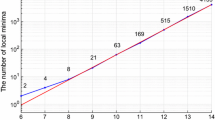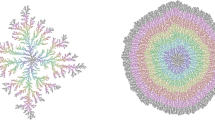Abstract
This article provides summary of some of our results, concerning a model of aggregation and fragmentation of clusters of particles obeying the stochastic discrete-time discrete-space kinetics of the generalized Totally Asymmetric Simple Exclusion Process (gTASEP) with open boundaries. The model in essence is the ordinary TASEP with backward ordered sequential update with special kinematic interaction added, i.e., it has a second modified hopping probability \(~{{p}_{m}}\) for particles in a cluster in addition to the standard hopping probability \(p\). We consider separately the two cases of attraction interaction (\(p\) < \(~{{p}_{m}}\)): (1) the limiting case of irreversible aggregation (\({{p}_{m}}\) = 1); and (2) the generic case of attraction, when \(~p\) < \(~{{p}_{m}}\) < 1 (then aggregation and fragmentation of clusters is allowed). We put special emphasis on the use of random walk theory in the study of gTASEP. It is applied to study the inter-cluster gaps time evolution, which helps to assess the properties of the nonequilibrium stationary phases of the system and the phase transitions between them. Theoretical conclusions are in agreement with the Monte Carlo simulations.











Similar content being viewed by others
REFERENCES
S. M. Kreidenweis, M. Petters, and U. Lohmann, “100 years of progress in cloud physics, aerosols, and aerosol chemistry research,” Am. Meteorol. Soc. 59, 11.1–11.72 (2019).
M. Alifierakis, K. S. Sallah, I. A. Aksay, and J. H. Prévost, “Reversible cluster aggregation and growth model for graphene suspensions,” AICh Eng. 63, 5462–5473 (2017).
G. R. Born and M. J. Cross, “Effects of inorganic ions and of plasma proteins on the aggregation of blood platelets by adenosine diphosphate,” J. Physiol. 170, 397–414 (1964).
M. Bourdenx, N. S. Koulakiotis, D. Sanoudou, E. Bezard, B. Dehay, and A. Tsarbopoulos, “Protein aggregation and neurodegeneration in prototypical neurodegenerative diseases: Examples of amyloidopathies, tauopathies and synucleinopathies,” Prog. Neurobiol. 155, 171–193 (2015).
M. H. Lee, “On the validity of the coagulation equation and the nature of runaway growth,” Icarus 143, 74–86 (2000).
J. P. Taylor, J. Hardy, and K. H. Fischbeck, “Toxic proteins in neurodegenerative disease,” Science 296, 1991 (2002).
J. Krug, “Boundary-induced phase transitions in driven diffusive systems,” Phys. Rev. Lett. 67, 1882 (1991).
D. Chowdhury, L. Santen, and A. Schadschneider, “Statistical physics of vehicular traffic and some related systems,” Phys. Rep. 329, 199 (2000).
S. Katz, J. L. Lebowitz, and H. Spohn, “Phase transitions in stationary nonequilibrium states of model lattice systems,” Phys. Rev. B 28, 1655 (1983).
S. Katz, J. L. Lebowitz, and H. Spohn, “Nonequilibrium steady states of stochastic lattice gas models of fast ionic conductors,” J. Stat. Phys. 34, 497–537 (1984).
K. Nagle, “Particle hopping models and traffic flow theory,” Phys. Rev. E 53, 4655 (1996).
D. Helbing, “Traffic and related self-driven many-particle systems,” Rev. Mod. Phys. 73, 1067 (2001).
T. Tripathi and D. Chowdhury, “Interacting RNA polymerase motors on a DNA track: Effects of traffic congestion and intrinsic noise on RNA synthesis,” Phys. Rev. E. 77, 011921 (2008).
S. Klumpp and R. Lipowsky, “Traffic of molecular motors through tube-like compartments,” J. Stat. Phys. 113, 233 (2003).
P. Greulich, A. Garai, K. Nishinari, A. Schadschneider, and D. Chowdhury, “Intracellular transport by single-headed kinesin KIF1A: Effects of single-motor mechanochemistry and steric interactions,” Phys. Rev. E 75, 041905 (2007).
A. B. Kolomeisky, “Channel-facilitated molecular transport across membranes: Attraction, repulsion, and asymmetry,” Phys. Rev. Lett. 98, 048105 (2007).
A. Zilman, J. Pearson, and G. Bel, “Effects of jamming on nonequilibrium transport times in nanochannels,” Phys. Rev. Lett. 103, 128103 (2009).
P. Meakin, P. Ramanlal, L. M. Sander, and R. Ball, “Ballistic deposition on surfaces,” Phys. Rev. A 34, 5091 (1986).
C. T. MacDonald, J. H. Gibbs, and A. C. Pipkin, “Kinetics of biopolymerization on nucleic acid templates,” Biopolymers 6, 1 (1968).
F. Spitzer, “Interaction of Markov processes,” Adv. Math 5, 246–290 (1970).
B. Derrida, E. Domany, and D. Mukamel, “An exact solution of a one-dimensional asymmetric exclusion model with open boundaries,” J. Stat. Phys. 69, 66 (1992).
G. M. Schütz and E. Domany, “Phase transitions in an exactly soluble one-dimensional exclusion process,” J. Stat. Phys. 72, 277 (1993).
B. Derrida, M. R. Evans, V. Hakim, and V. Pasquier, “Exact solution of a 1D asymmetric exclusion model using a matrix formulation,” J. Phys. A 26, 1493 (1993).
H. Hinrichsen, “Matrix product ground states for exclusion processes with parallel dynamics,” J. Phys. A 29, 3659 (1996).
A. Honecker and I. Peschel, “Matrix-product states for a one-dimensional lattice gas with parallel dynamics,” J. Stat. Phys. 88, 319 (1997).
M. R. Evans, N. Rajewsky, and E. R. Speer, “Exact solution of a cellular automaton for traffic,” J. Stat. Phys. 95, 45 (1999).
J. de Gier and B. Nienhuis, “Exact stationary state for an asymmetric exclusion process with fully parallel dynamics,” Phys. Rev. E 59, 4899 (1999).
N. Rajewski, A. Schadschneider, and M. Schreckenberg, “The asymmetric exclusion model with sequential update,” J. Phys. 29, 305 (1996).
N. Rajewski and M. Schreckenberg, “Exact results for one-dimensional cellular automata with different types of updates,” Physica A 245, 239 (1997).
N. Rajewski, L. Santen, A. Schadschneider, and M. Schreckenberg, “The asymmetric exclusion process: Comparison of update procedures,” J. Stat. Phys. 92, 151 (1998).
N. Zh. Bunzarova and N. C. Pesheva, “One-dimensional irreversible aggregation with dynamics of a totally asymmetric simple exclusion process,” Phys. Rev. E 95, 052105 (2017).
J. G. Brankov, N. Zh. Bunzarova, N. C. Pesheva, and V. B. Priezzhev, “A model of irreversible jam formation in dense traffic,” Physica A 494, 340 (2018).
N. Zh. Bunzarova, N. C. Pesheva, V. B. Priezzhev, and J. G. Brankov, “A model of jam formation in congested traffic,” J. Phys.: Conf. Ser. 936, 012026 (2017).
N. Zh. Bunzarova, N. C. Pesheva, and J. G. Brankov, “One-dimensional discrete aggregation-fragmentation model,” Phys. Rev. E. 100, 0022145 (2019).
M. Wölki, Master Thesis (Univ. Duisburg-Essen, Duisburg, 2005).
A. E. Derbyshev, S. S. Poghosyan, A. M. Povolotsky, and V. B. Priezzhev, “The totally asymmetric exclusion process with generalized update,” J. Stat. Mech., 05014 (2012).
A. E. Derbyshev, A. M. Povolotsky, and V. B. Priezzhev, “Emergence of jams in the generalized totally asymmetric simple exclusion process,” Phys. Rev. E 91, 022125 (2015).
B. L. Aneva and J. G. Brankov, “Matrix-product ansatz for the totally asymmetric simple exclusion process with a generalized update on a ring,” Phys. Rev. E 94, 022138 (2016).
P. Hrabák, Ph.D. Thesis (Czech Tech. Univ. Prague, Prague, 2014).
P. Hrabák and M. Krbálek, “Time-headway distribution for periodic totally asymmetric exclusion process with various updates,” Phys. Lett. A 380, 1003–1011 (2016).
N. C. Pesheva and N. Zh. Bunzarova, “gTASEP with attraction interaction on lattices with open boundaries,” arXiv:2001.02010v1, (2020).
S. Janowsky and J. Lebowitz, “Finite size effects and shock fluctuations in the asymmetric simple exclusion process,” Phys. Rev. A 45, 618–625 (1992).
S. Janowsky and J. Lebowitz, “Exact results for the asymmetric simple exclusion process with a blockage,” J. Stat. Phys. 77, 35–51 (1994).
A. Jindal, T. Midha, and A. K. Gupta, “Analysis of interactions in totally asymmetric exclusion process with site-dependent hopping rates: Theory and simulations,” J. Phys. A 53, 235001 (2020).
C. Bahadoran and T. Bodineau, “Properties and conjectures for the flux of TASEP with site disorder,” Braz. J. Probab. Stat. 29, 282–312 (2015).
C. Arita, M. E. Foulaadvand, and L. Santen, “Signal optimization in urban transport: A totally asymmetric simple exclusion process with traffic lights,” Phys. Rev. E 95, 032108 (2017).
A. Jindal, A. B. Kolomeisky, A. K. Gupta, The role of dynamic defects in transport of interacting molecular motors, Journal of Statistical Mechanics 2020. V. 2020 P. 043206.
J. Brankov, N. Pesheva, and N. Bunzarova, “Totally asymmetric exclusion process on chains with a double-chain section in the middle: Computer simulations and a simple theory,” Phys. Rev. E 69, 066128 (2004).
I. Neri, N. Kern, and A. Parmeggiani, “TASEP transport on networks: Theory for strongly connected networks,” Phys. Rev. Lett. 107, 068702 (2011).
Y. Baek, M. Ha, and H. Jeong, “Effects of junctional correlations in the totally asymmetric simple exclusion process on random regular networks,” Phys. Rev. E 90, 062111 (2014).
B. Pal and A. K. Gupta, “Role of interactions in a closed quenched system,” arXiv:2002.07075 (2020).
L. Grüne, T. Kriecherbauer, and M. Margaliot, “Random attraction in the TASEP model,” arXiv:2001-07764 (2020).
ACKNOWLEDGMENTS
The authors gratefully acknowledge joint work and fruitful discussions with their late colleagues and coauthors, Prof. V.B. Priezzhev and Prof. J.G. Brankov. Many results presented here are obtained in collaboration with them. This article is based on the presentation given at Memorial seminar dedicated to Vyacheslav Priezzhev. The authors very much appreciate the invitation and the support provided by the organizing committee of the Memorial seminar. Partial financial supports by the Bulgarian MES through Grant no. D01-221/03.12.2018 for NCDSC—part of the Bulgarian National Roadmap on RIs, and by the Plenipotentiary Representative of the Bulgarian Government at the Joint Institute for Nuclear Research, Dubna, through grant no. 01-3-1137-2019/2023 also are thankfully acknowledged.
Author information
Authors and Affiliations
Corresponding author
Rights and permissions
About this article
Cite this article
Bunzarova, N.Z., Pesheva, N.C. Aggregation-Fragmentation of Clusters in the Framework of gTASEP with Attraction Interaction. Phys. Part. Nuclei 52, 169–184 (2021). https://doi.org/10.1134/S1063779621020027
Received:
Revised:
Accepted:
Published:
Issue Date:
DOI: https://doi.org/10.1134/S1063779621020027




